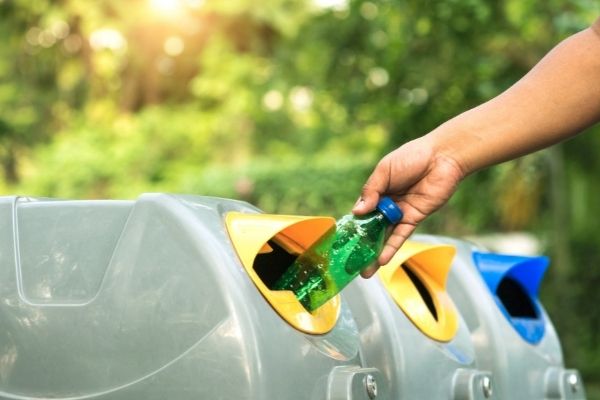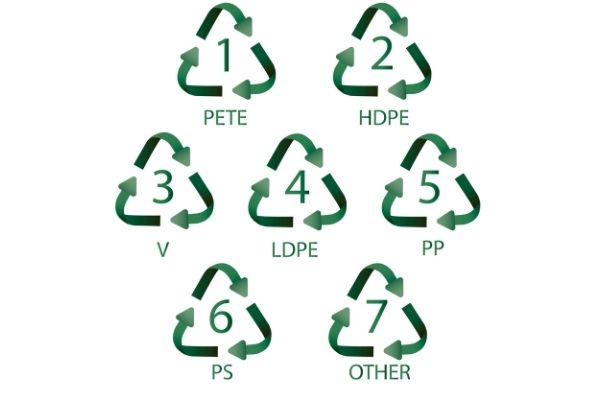There are loads of statistics on how much or how little we recycle and plenty of information on how to do it. Before you explore these details, it’s useful to understand how does recycling help the environment?
Our responsibility is to preserve and protect the earth for ourselves and future generations and all the other living things that call earth home.
Below we explain the importance of recycling and how recycling helps the environment. We’ll also provide some handy recycling tips on the top four recycling materials, including paper, plastic, metal, and glass.
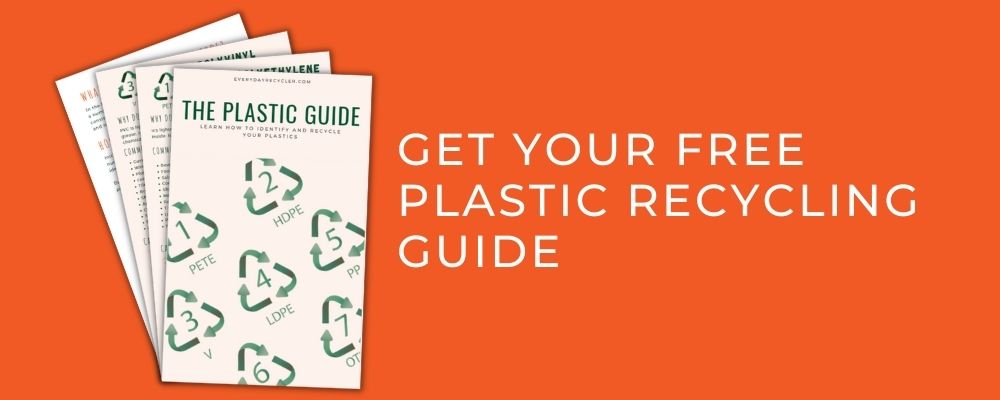
Why is recycling important?
Recycling is the process of separating, collecting, processing and remanufacturing, or converting used or waste products into new materials.
Recycling is a part of the three golden rules of sustainability: Reduce, Reuse, and Recycle. We recommend you reduce as much as you can first. You can find some tips for doing this in How to reduce and reuse: ways to get you thinking.
Recycling has been around for a very long time. Our parents and grandparents grew up in an era where you used what you had and didn’t waste anything. This was especially important during war times when materials were scarce. It may not have been the same as recycling today, but the outcome was similar.
Unfortunately, we now live in what is known as a throwaway society. Since our parent’s time, many things have changed. We come into contact with many more products and associated packaging daily. Plus, convenience has led us down a path where materials and objects in our lives are easily replaceable, so we value them less.
This throwaway mentality is what has helped to create the global waste crisis. After half a century of this lifestyle, we are seeing devastating effects on our environment.
The natural environment is impacted by how much or how little we recycle. The best part about recycling is everybody can make a difference.
By changing just one habit or learning how to recycle correctly, you can reduce the amount of waste you create. You can also help increase the demand for recycled materials used in new products.
Why not get started today and learn how recycling helps the environment?
Recycling and waste facts?
Did you know these facts about recycling and waste?
- Plastic will outnumber fish by 2050
- About 269,000 tons of plastic waste floats in the ocean.
- A plastic bag is used for only 15 minutes on average but can last for a millennium.
- 91% of plastic isn’t recycled
- Americans throw away 35 billion plastic bottles every year.
- It takes as little as 30 days for the recycled glass to appear on a store shelf.
- People have used more resources in the last 50 years than in all of history.
- Americans send back only 25% of their cardboard for reuse.
- Recycling one tonne of paper saves 13 trees and 31,780 liters of water.
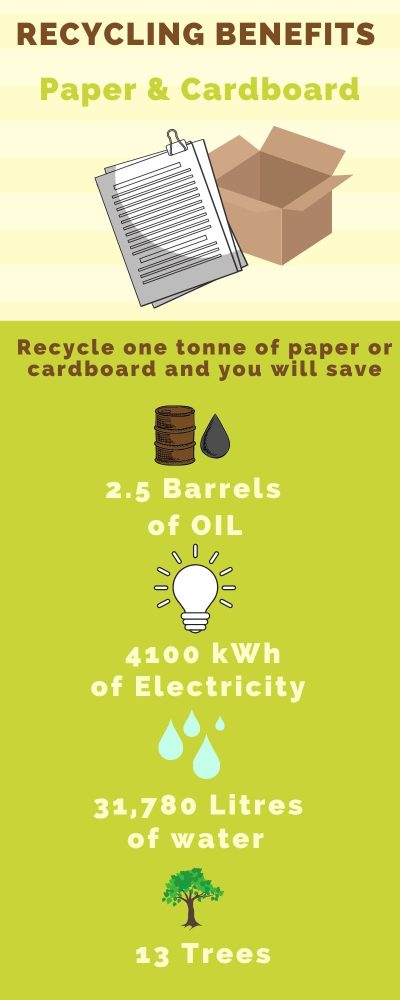
How does recycling help the environment?
How does recycling help the environment? There are many ways that the environment and our planet benefit from recycling. Below we take you through the key areas and explain why recycling is important.
Recycling saves energy
Recycling helps the environment by saving energy for the future.
We can save a great deal of energy by properly recycling metals, plastics, glass, and paper.
How does recycling save energy? Energy is saved by reducing the amount of virgin materials extracted, processed, manufactured, and transported to create new products. Recycling correctly helps keep resources that have already been extracted in use and reduces our need for more resulting in less energy use overall.
Some great examples are:
- Recycling aluminum is an energy-efficient process that saves 95% of the energy required to manufacture it. Recycling also eliminates dangerous chemicals and greenhouse gases from being produced, making it a much better option for the environment than producing new aluminum.
- The EPA estimates recycling metals lowers greenhouse-gas emissions by about 50% and saves more than $11 billion in annual energy costs.
- Plastic recycling can save up to 80% of total petroleum use. This reduces the amount of virgin plastic used and, therefore, the amount of fossil fuels.
- Using recycling glass can reduce energy use by 75% compared to making new glass.
You can learn more ways to save energy in 13 Ways to Reduce Your Carbon Footprint at Home.
Recycling Conserves Resources
The amount of natural resources such as fossil fuels and mineral ores available on the planet is limited. These natural resources will eventually run out. When products made from these natural resources are discarded in landfills, they are potentially lost forever.
Recycling keeps materials in circulation and ensures that we get the full value from them. It takes a great deal of energy and resources to extract and process these materials, so it seems ridiculous to use them once and simply throw them away.
More and more recycled products are being created everyday. Innovative brands are finding ways to reuse materials in new ways and keep these materials in use. Check out our Brand Directory to learn more about these Brands.
Recycling creates jobs
The EPA released research on the economic benefits of recycling in 2016, where they found that every dollar spent on recycling creates four jobs for Americans. Recycling facilities train and employ four workers for every worker that a landfill maintains, which provides a significant number of jobs.
Recycling also helps create new industries and businesses that find a use for recycled materials.
Recycling supports the SDGs
Recycling is one of the best ways to support the Sustainable Development Goals developed by the United Nations.
The United Nations created these goals in 2015 as a call to action to end poverty, protect the environment and ensure that people worldwide enjoy peace and prosperity.
Recycling supports these goals by reducing our use of natural resources, protecting the natural environment from waste and pollution, and creating new economies for prosperity and growth.
Recycling supports a circular economy
Our current way of producing, consuming, and disposing of materials is reaching its limits. Waste’s piling up, resources are running out, and every corner of the globe suffers from the impacts.
A circular economy model can help. If you haven’t heard the term before, a circular economy is a model that regenerates as natural systems do. A circular economy is not just about reducing waste and increasing recycling. It’s about creating a more natural economy that can benefit society and the environment.
The Ellen Macarthur Foundation defines the circular economy as:
A circular economy is based on the principles of designing out waste and pollution, keeping products and materials in use, and regenerating natural systems.
Ellen Macarthur Foundation Tweet
The three principles of the circular economy are:
- Design out waste and pollution
- Keep products and materials in use
- Regenerate natural systems
In a circular economy system, products are designed with the end in mind. They are also built to be repaired and recycled into new products once they are no longer useful.
Recycling supports a circular economy by keeping materials in use longer.
You can learn more in the Beginners guide to the Circular Economy?
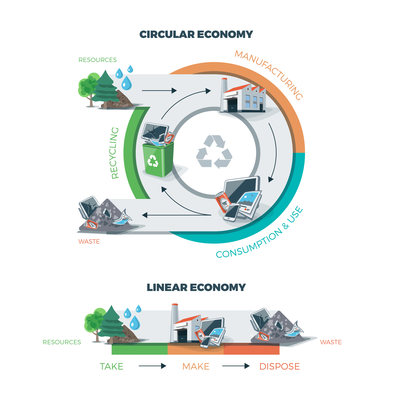
Recycling protects ecosystems and wildlife
To protect ecosystems and wildlife, we must recycle plastic waste. This waste is having a devastating effect on our oceans and waterways. Recycling plastic helps decrease the pollution in our rivers and oceans.
It’s not all about plastic either. Recycling reduces the number of trees cut down and the minerals and resources we extract from the earth. All of which harm the environment.
We must take these steps to protect our beautiful environment and protect the animals that live in it.
Recycling reduces landfill
Recycling helps reduce the volume of waste in landfills and diverts tons of hazardous waste away from landfills every day.
This reduces the risk of landfill sites releasing toxic chemicals and other harmful materials into the environment.
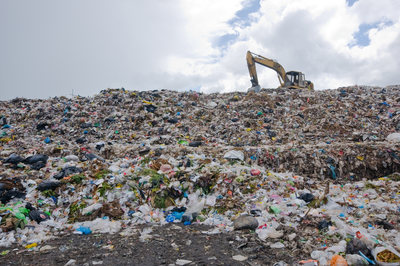
Why is recycling important to future generations?
Recycling is vital to future generations because it saves non-renewable materials from going to waste and prevents pollution. It supports circular economy principles for keeping materials in circulation.
Recycling also protects and preserves the natural environment for future generations to enjoy. We already see the devastating effects our overconsumption and waste creation has on the oceans, rivers, and land.
We need to not only stop the flow but reverse it by making materials valuable at the end of their life.
Close your loop
Recycling is not just about knowing the answer to how does recycling helps the environment? It’s also about understanding the full circle.
Once you have mastered recycling, the next best thing you can do to help is to buy recycled products.
Buying recycled helps ensure materials remain in demand and that the recycling industry is sustainable.
We make finding recycled products easy by providing a Brand directory and recycled product guides just for you.
Below are some fantastic examples of recycled products made from recycled plastic.

Recycled Backpack
Featuring First Mile® waxed canvas made from 100% recycled post-consumer plastic bottles, plus 100% recycled polyester lining and trim, algae-based foam, water repellant neoprene, and conflict-free metal YKK zippers.
And they look amazing!

Recycled board shorts
Board shorts for men and boys made from recycled PET plastic using post-consumer plastic bottles. They also use tree bark (Tencel) and spandex in their classic long-sleeved top.

Recycled Activewear
This reversible, midlength tank top and matching joggers are both made using post-consumer recycled plastic — 84% RPET and 16% spandex.
That’s 20 plastic bottles used to make the tank top and 50 for the joggers. Thats a total of 70 plastic bottles saved from landfill.
Tips on how to recycle
Below are some tips on recycling to help get you started.
How to recycle plastics
It doesn’t take long to learn some of the basics about plastics and how to recycle them. Here are a few quick tips:
What are the different types of plastic?
When it comes to recycling, there are two main categories of plastics, rigid plastics and soft plastics.
- Rigid plastics are firm and will hold their shape like shampoo bottles.
- Soft plastics are those plastics that can be scrunched up and stay scrunched. Good examples of soft plastics are plastic bags or pasta packaging.
Plastics can have many different properties
There are many types of plastics with different properties.
One of the best tools to understand the different types and recycle them is the Plastic number system.
You may have seen this system before. It’s represented as a number inside a chasing arrow symbol on the packaging, see picture below.
These symbols do not always mean it is recyclable. They help identify the type of plastic it’s made from. Get our free plastic recycling guide by subscribing below.
Which plastic numbers can you recycle?
Generally, plastic numbers 1, 2, 4, and 5 can be recycled in your curbside recycling bin, and numbers 3, 6, and 7 cannot.
How does plastic recycling help the environment?
Learn more about how plastic recycling can help the environment in the following articles:
Or why not subscribe and get our plastic recycling guide

How to recycle paper
Paper and cardboard can be recycled easily, but there are a few tips to help make it simpler:
- Clean and dry cardboard, magazines, office paper, phone books, and junk mail can all be recycled in your curbside bin.
- Waxed paper, receipts, paper towels, tissues, shredded paper, and photos all stay out of your recycling bin and must go in the trash can.
- Items made from paper layered with plastic or aluminum, such as long-life milk containers, are challenging to recycle. Only a few places will accept them, so check with your local authority.
- Many types of wrapping paper cannot be recycled because they are coated in plastic or metal. These are usually the shiny type or have glitter.
How to recycle glass
Even though glass is often referred to as better than plastic, it still has an impact. It’s a good idea to reduce how much you use and reuse what you have. It’s also a good idea to recycle what you no longer need.
Glass is tough and can take up to 1 million years to degrade, so even though it will not damage the environment, it can build up.
Here are some tips:
- Only place glass bottles and jars in your curbside recycling bin. Many other glass objects cannot be recycled in your curbside bin. This is because the glass has additives like lead or aluminum oxide, or it has been heat-treated. These processes make it much more difficult to recycle the glass.
- If you can’t figure out what type of glass it is, it is better to put the item in your landfill bin rather than contaminate a whole batch of glass recycling. An excellent article to read is, Are you wish cycling? 5 ways to help you break your habit.
- One of the most important things you can do is check with your local authority to see the rules in your area. This might be your local council, or it might be the nearest bottle bank. There are different rules in every location, so checking is essential.
- Some local authorities in America and Australia have removed glass from their curbside pickup. The problem is that when glass breaks up during the recycling process, small glass shards can contaminate the other recyclables like paper and plastic. This can result in these materials being sent to landfills.
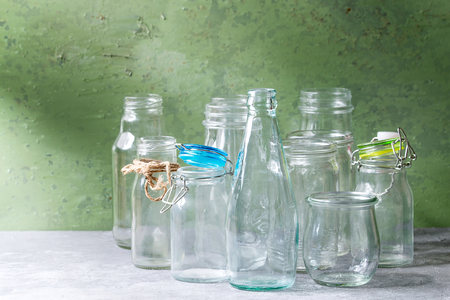
Once you’ve checked your local rules and the type of glass, follow these steps:
- Remove metal or plastic lids or caps.
- Rinse the container (place it in your dishwasher with your other dishes to save water).
- Do not break the glass. Leave it intact. Do not put broken glass into your recycling bin.
You can learn more about glass and glass recycling here.
How to recycle metals
The most important thing to understand when recycling your metals is whether or not the type of metal is accepted in your curbside recycling.
The primary items that are accepted by most curbside recycling services include:
- Food Cans – aluminum cans or steel cans for soup or other foods
- Drink Cans – beer and soft drink cans, these are traditionally aluminum
- Lids and bottle caps – larger caps from food jars (Note check what your local area accepts when it comes to beer, soft drinks caps, learn more in Can You Recycle Bottle Caps?)
- Aluminum foil and foil baking trays
Your curbside pickup services will typically not allow any large or complex metal for recycling like car parts, appliances, or electronics to be included. To recycle these, you can take the metal to a scrap yard.
Any metal objects with a chord or battery are defined as e-waste and should be disposed of appropriately.
Aerosol spray cans that are still full or partly full are treated as hazardous waste. You can either empty them before throwing them out or find out if your local authority has a hazardous waste drop-off.
Other metals that don’t belong in your curbside recycling bin are Ironing boards, metal coat hangers, silverware, keys, furniture, Household appliances, white goods like fridges or freezers, roofing, electrical wire, car or bicycle parts, razor blades, umbrellas, toys, tools, eyeglass frames.
Many of these metal objects can be recycled through a specialist metal scrap yard. Be sure to find one in your local area.
Learn more here.
Conclusion
How does recycling help the environment? Understanding this is fundamental to recognizing the difference we can make and how important it is we all get involved.
Recycling saves energy, reduces pollution and greenhouse gases, conserves natural resources, and keeps Earth’s creatures safe. Recycling also creates new industries and jobs.
The next time you throw something out, ask yourself am I disposing of this correctly? Can it be recycled? How much energy was used to get the materials from the environment? Can someone use this to make a new product?
Each of us needs to rethink our ideas about rubbish disposal and understand the importance of recycling.
We can all make a difference!


